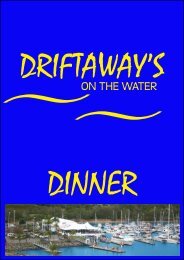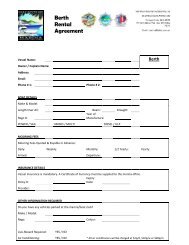Half Moon Bay Marina Cyclone Contingency Plan - Yorkeys Knob ...
Half Moon Bay Marina Cyclone Contingency Plan - Yorkeys Knob ...
Half Moon Bay Marina Cyclone Contingency Plan - Yorkeys Knob ...
You also want an ePaper? Increase the reach of your titles
YUMPU automatically turns print PDFs into web optimized ePapers that Google loves.
In addition to the general points made above, marina-based safety plans need to consider the following issues. It is<br />
important that you discuss this with your marina management to understand their requirements so that your plan is<br />
consistent with marina operations:<br />
The loadings on marina berths<br />
Some marinas allow for berths to remain occupied provided the berth has a pontoon equivalent to the overall length<br />
(LOA) of the vessel occupying it. Vessels may also be allowed to bear against the fingers/pontoons noting that<br />
suitable or additional fendering is likely to be required.<br />
Mooring considerations<br />
Double up mooring lines, by running duplicated ropes to alternative bollards. Do not run duplicates to the same<br />
bollards – a single bollard failure should not release the craft from a safe mooring arrangement. The duplicate lines<br />
should be in good condition and run slightly slack to ensure that they are only required to work in the event of the<br />
chafing through the primary mooring lines. Vessels should not be secured to piles as this prevents pontoons moving<br />
with tidal and surge movements. Take particular care to protect against chafing. Ensure lines are made fast to<br />
substantial boat parts, for example mast steps, winches and so on, bearing in mind cleats are known to have been<br />
torn out of decks. Do not use chain to secure your boat to pontoon bollards. Chains have no ability to stretch, where<br />
ropes have a certain amount of give. Some marinas allow for anchors to be lowered in the marina berth to the sea<br />
bottom. Ensure there is enough slack to rise and fall of the vessel due to swell and storm surges. If the master or<br />
owner elects to stay on-board with the vessel, any mooring lines should be adjustable from onboard and sufficiently<br />
taut to ensure the vessel and pontoon move as one.<br />
Other factors<br />
You are likely to be required to disconnect all shore power leads and water hoses. Some marinas have particular<br />
arrangements for the stowage of vessel tenders. <strong>Marina</strong> management may determine the time when personnel are<br />
barred from the pontoons and/or hardstand areas. Ensure that you abide by any such direction.<br />
Hardstand storage<br />
Hardstand storage is a viable alternative for trailer vessels or vessels undergoing maintenance. However, vessel windage<br />
is considerably increased through hardstand storage. In such situations, owners and masters of vessels should:<br />
<br />
<br />
<br />
<br />
place the vessel head to the wind if possible<br />
take particular care to secure and stow all deck items<br />
ensure wheels are chocked and trailer brakes applied<br />
attach the trailer or cradle to the nearest strong point(s).<br />
You should note that flying debris, particularly in the hardstand areas, can cause serious injury or may be lethal during a<br />
severe weather event. Please exercise all due care when operating in these areas.<br />
Extreme weather event contingency plan – <strong>Half</strong> <strong>Moon</strong> <strong>Bay</strong>, Maritime Safety Queensland, November 2011 8 of 8






